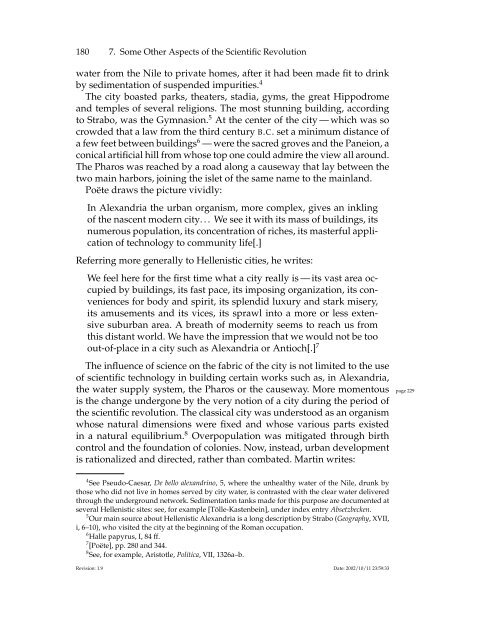1 The Birth of Science - MSRI
1 The Birth of Science - MSRI
1 The Birth of Science - MSRI
Create successful ePaper yourself
Turn your PDF publications into a flip-book with our unique Google optimized e-Paper software.
180 7. Some Other Aspects <strong>of</strong> the Scientific Revolution<br />
water from the Nile to private homes, after it had been made fit to drink<br />
by sedimentation <strong>of</strong> suspended impurities. 4<br />
<strong>The</strong> city boasted parks, theaters, stadia, gyms, the great Hippodrome<br />
and temples <strong>of</strong> several religions. <strong>The</strong> most stunning building, according<br />
to Strabo, was the Gymnasion. 5 At the center <strong>of</strong> the city — which was so<br />
crowded that a law from the third century B.C. set a minimum distance <strong>of</strong><br />
a few feet between buildings 6 — were the sacred groves and the Paneion, a<br />
conical artificial hill from whose top one could admire the view all around.<br />
<strong>The</strong> Pharos was reached by a road along a causeway that lay between the<br />
two main harbors, joining the islet <strong>of</strong> the same name to the mainland.<br />
Poëte draws the picture vividly:<br />
In Alexandria the urban organism, more complex, gives an inkling<br />
<strong>of</strong> the nascent modern city. . . We see it with its mass <strong>of</strong> buildings, its<br />
numerous population, its concentration <strong>of</strong> riches, its masterful application<br />
<strong>of</strong> technology to community life[.]<br />
Referring more generally to Hellenistic cities, he writes:<br />
We feel here for the first time what a city really is — its vast area occupied<br />
by buildings, its fast pace, its imposing organization, its conveniences<br />
for body and spirit, its splendid luxury and stark misery,<br />
its amusements and its vices, its sprawl into a more or less extensive<br />
suburban area. A breath <strong>of</strong> modernity seems to reach us from<br />
this distant world. We have the impression that we would not be too<br />
out-<strong>of</strong>-place in a city such as Alexandria or Antioch[.] 7<br />
<strong>The</strong> influence <strong>of</strong> science on the fabric <strong>of</strong> the city is not limited to the use<br />
<strong>of</strong> scientific technology in building certain works such as, in Alexandria,<br />
the water supply system, the Pharos or the causeway. More momentous page 229<br />
is the change undergone by the very notion <strong>of</strong> a city during the period <strong>of</strong><br />
the scientific revolution. <strong>The</strong> classical city was understood as an organism<br />
whose natural dimensions were fixed and whose various parts existed<br />
in a natural equilibrium. 8 Overpopulation was mitigated through birth<br />
control and the foundation <strong>of</strong> colonies. Now, instead, urban development<br />
is rationalized and directed, rather than combated. Martin writes:<br />
4 See Pseudo-Caesar, De bello alexandrino, 5, where the unhealthy water <strong>of</strong> the Nile, drunk by<br />
those who did not live in homes served by city water, is contrasted with the clear water delivered<br />
through the underground network. Sedimentation tanks made for this purpose are documented at<br />
several Hellenistic sites: see, for example [Tölle-Kastenbein], under index entry Absetzbecken.<br />
5 Our main source about Hellenistic Alexandria is a long description by Strabo (Geography, XVII,<br />
i, 6–10), who visited the city at the beginning <strong>of</strong> the Roman occupation.<br />
6 Halle papyrus, I, 84 ff.<br />
7 [Poëte], pp. 280 and 344.<br />
8 See, for example, Aristotle, Politica, VII, 1326a–b.<br />
Revision: 1.9 Date: 2002/10/11 23:59:33










